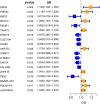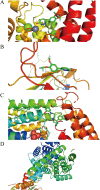Focusing on spinal stenosis: emerging discoveries concerning Alendronate-induced risks and genetic drug targets
- PMID: 40320523
- PMCID: PMC12051279
- DOI: 10.1186/s13018-025-05854-5
Focusing on spinal stenosis: emerging discoveries concerning Alendronate-induced risks and genetic drug targets
Abstract
Background: Spinal stenosis is a common disease in clinical practice, and drug use is one of its potential predisposing factors. Alendronate, a widely used clinical drug for osteoporosis treatment, has the potential to trigger spinal stenosis. Based on the real world, this study aims to deeply investigate the association between spinal stenosis and alendronate, and to explore novel drug targets against spinal stenosis at the genetic level.
Methods: Alendronate patient data from the FDA Adverse Event Reporting System (FAERS) from Q1 2004 to Q4 2024 were included in the study, and four pharmacovigilance analytic methods and Bonferroni corrected P-values were applied to the baseline data, and subgroups of data were analyzed. Complementarily, Weibull distribution were applied to further parse the data. Meanwhile, in order to explore therapeutic targets against spinal stenosis, Mendelian randomization analyses were carried out based on eQTLGen consortium data as well as genome-wide association study (GWAS) data from two large independent cohorts. Subsequently, the medicinal value of the identified drug targets was verified by drug prediction and molecular docking techniques.
Results: Pharmacovigilance analysis showed a strong positive signal between alendronate and spinal stenosis, especially in females and older patients. Fourteen significant drug targets were identified. Their medicinal value was verified by drug prediction and molecular docking, obtaining four protein-drug docking model structures.
Conclusions: This study reveals an alendronate-spinal stenosis association, offering insights for clinical prevention. It also identifies new genetic drug targets, opening new treatment pathways for spinal stenosis.
Trial registration: Not applicable.
Keywords: Alendronate; Drug targets; Mendelian randomization; Pharmacovigilance analysis; Spinal stenosis.
© 2025. The Author(s).
Conflict of interest statement
Declarations. Ethics approval and consent to participate: Not applicable. Consent for publication: Not applicable. Competing interests: The authors declare no competing interests.
Figures









Similar articles
-
Unveiling therapeutic targets for spinal stenosis from genetic insights: a Mendelian randomization analysis.Sci Rep. 2024 Nov 24;14(1):29118. doi: 10.1038/s41598-024-80697-4. Sci Rep. 2024. PMID: 39582071 Free PMC article.
-
Pharmacovigilance of oral bisphosphonates: adverse effects manifesting in the soft tissue of the oral cavity.J Oral Maxillofac Surg. 2012 Dec;70(12):2793-7. doi: 10.1016/j.joms.2012.01.025. Epub 2012 May 19. J Oral Maxillofac Surg. 2012. PMID: 22609135
-
Drug risks associated with sarcopenia: a real-world and GWAS study.BMC Pharmacol Toxicol. 2024 Nov 7;25(1):84. doi: 10.1186/s40360-024-00813-y. BMC Pharmacol Toxicol. 2024. PMID: 39511635 Free PMC article.
-
Screening for the primary prevention of fragility fractures among adults aged 40 years and older in primary care: systematic reviews of the effects and acceptability of screening and treatment, and the accuracy of risk prediction tools.Syst Rev. 2023 Mar 21;12(1):51. doi: 10.1186/s13643-023-02181-w. Syst Rev. 2023. PMID: 36945065 Free PMC article.
-
Bisphosphonate alternative regimens for the prevention of osteoporotic fragility fractures: BLAST-OFF, a mixed-methods study.Health Technol Assess. 2024 Apr;28(21):1-169. doi: 10.3310/WYPF0472. Health Technol Assess. 2024. PMID: 38634483 Free PMC article.
Cited by
-
Concerns and questions regarding "Focusing on spinal stenosis: emerging discoveries concerning Alendronate-induced risks and genetic drug targets".J Orthop Surg Res. 2025 May 27;20(1):526. doi: 10.1186/s13018-025-05921-x. J Orthop Surg Res. 2025. PMID: 40426244 Free PMC article. No abstract available.
References
-
- Kim SL, Lim RD. Spinal stenosis. Dis Mon. 2005;51:6–17. - PubMed
-
- Katz JN, Zimmerman ZE, Mass H, Makhni MC. Diagnosis and Management of Lumbar Spinal Stenosis: A Review. JAMA. 2022;327:1688–99. - PubMed
-
- Lai M, Cheung P, Cheung J. A systematic review of developmental lumbar spinal stenosis. Eur Spine J. 2020;29:2173–87. - PubMed
-
- Sharpe M, Noble S, Spencer CM. Alendronate: an update of its use in osteoporosis. Drugs. 2001;61:999–1039. - PubMed
MeSH terms
Substances
Grants and funding
LinkOut - more resources
Full Text Sources
Medical

